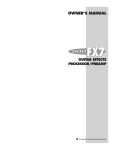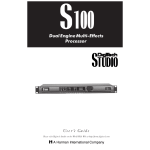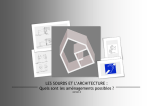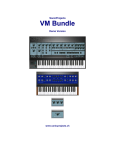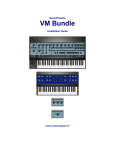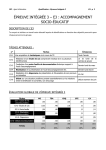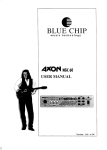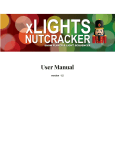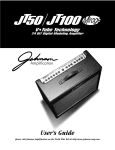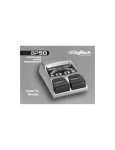Download DigiTech S200 User`s guide
Transcript
Dual-Engine Multi-Effects Processor User’s Guide Please visit Digitech Studio on the World Wide Web at http://www.digitech.com WARNING CAUTION FOR YOUR PROTECTION, PLEASE READ THE FOLLOWING: RISK OF ELECTRIC SHOCK DO NOT OPEN A T T E N T I O N : RISQUE DE CHOC ELECTRIQUE - NE PAS OUVRIR W A R N I N G : TO REDUCE THE RISK OF FIRE OR ELECTRIC SHOCK DO NOT EXPOSE THIS EQUIPMENT TO RAIN OR MOISTURE The symbols shown above are internationally accepted symbols that warn of potential hazards with electrical products.The lightning flash with arrowpoint in an equilateral triangle means that there are dangerous voltages present within the unit.The exclamation point in an equilateral triangle indicates that it is necessary for the user to refer to the owner’s manual. These symbols warn that there are no user serviceable parts inside the unit. Do not open the unit. Do not attempt to service the unit yourself. Refer all servicing to qualified personnel. Opening the chassis for any reason will void the manufacturer’s warranty. Do not get the unit wet. If liquid is spilled on the unit, shut it off immediately and take it to a dealer for service. Disconnect the unit during storms to prevent damage. WATER AND MOISTURE: Appliance should not be used near water (e.g. near a bathtub, washbowl, kitchen sink, laundry tub, in a wet basement, or near a swimming pool, etc). Care should be taken so that objects do not fall and liquids are not spilled into the enclosure through openings. POWER SOURCES: The appliance should be connected to a power supply only of the type described in the operating instructions or as marked on the appliance. GROUNDING OR POLARIZATION: Precautions should be taken so that the grounding or polarization means of an appliance is not defeated. POWER CORD PROTECTION: Power supply cords should be routed so that they are not likely to be walked on or pinched by items placed upon or against them, paying particular attention to cords at plugs, convenience receptacles, and the point where they exit from the appliance. SERVICING: To reduce the risk of fire or electric shock, the user should not attempt to service the appliance beyond that described in the operating instructions. All other servicing should be referred to qualified service personnel. FOR UNITS EQUIPPED WITH EXTERNALLY ACCESSIBLE FUSE RECEPTACLE: Replace fuse with same type and rating only. U.K. MAINS PLUG WARNING ELECTROMAGNETIC COMPATIBILITY A moulded mains plug that has been cut off from the cord is unsafe. Discard the mains plug at a suitable disposal facility. NEVER UNDER ANY CIRCUMSTANCES SHOULD YOU INSERT A DAMAGED OR CUT MAINS PLUG INTO A 13 AMP POWER SOCKET. Do not use the mains plug without the fuse cover in place. Replacement fuse covers can be obtained from your local retailer. Replacement fuses are 13 amps and MUST be ASTA approved to BS1362. This unit conforms to the Product Specifications noted on the Declaration of Conformity. Operation is subject to the following two conditions: • this device may not cause harmful interference, and • this device must accept any interference received, including interference that may cause undesired operation. Operation of this unit within significant electromagnetic fields should be avoided. • use only shielded interconnecting cables. SAFETY INSTRUCTIONS NOTICE FOR CUSTOMERS IF YOUR UNIT IS EQUIPPED WITH A POWER CORD. WARNING: THIS APPLIANCE MUST BE EARTHED. The cores in the mains lead are coloured in accordance with the following code: GREEN and YELLOW - Earth BLUE - Neutral BROWN - Live As colours of the cores in the mains lead of this appliance may not correspond with the coloured markings identifying the terminals in your plug, proceed as follows: • The core which is coloured green and yellow must be connected to the terminal in the plug marked with the letter E, or with the earth symbol, or coloured green, or green and yellow. • The core which is coloured blue must be connected to the terminal marked N or coloured black. • The core which is coloured brown must be connected to the terminal marked L or coloured red. This equipment may require the use of a different line cord, attachment plug, or both, depending on the available power source at installation. If the attachment plug needs to be changed, refer servicing to qualified service personnel who should refer to the table below. The green/yellow wire shall be connected directly to the unit's chassis. CONDUCTOR WIRE COLOR L Line Brown Black N Neutral Blue White Earth Grnd. Green/Yel. Green WARNING: If the ground is defeated, certain fault conditions in the unit or in the system to which it is connected can result in full line voltage between chassis and earth ground. Severe injury or death can then result if the chassis and earth ground are touched simultaneously. S-200 DECLARATION OF CONFORMITY Manufacturer’s Name: Manufacturer’s Address: declares that the product: Product Name: Product Options: Digitech Studio 8760 S. Sandy Parkway Sandy, Utah 84070, USA S-200 All conforms to the following Product Specifications: Safety: EN 60065 (1993) IEC 65 (1985) with Amendments 1, 2 & 3 EMC: EN 55013 (1990) EN 55020 (1991) Supplementary Information: The product herewith complies with the requirements of the Low Voltage Directive 73/23/EEC and EMC Directive 89/336/EEC as amended by Directive 93/68/EEC. Digitech Studio President of Digitech Studio 8760 S. Sandy Parkway Sandy, Utah 84070, USA Tel: 801.566.8800 Fax: 801.566.7005 Effective May 1, 1998 European Contact: Your Local Digitech Studio Sales and Service Office or International Sales Office 3 Overlook Drive #4 Amherst, New Hampshire 03031, USA Tel: 603.672.4244 Fax: 603.672.4246 User Guide I S-200 Table of Contents Safety Information Declaration of Conformity................................................................I Table of Contents ............................................................................II Section 1 - Introduction Congratulations............................................................................1 Included Items ............................................................................1 S-200 Features ..............................................................................1 Warranty ......................................................................................2 A Quick Tour of the S-200 ............................................................3 The Front Panel............................................................................3 The Rear Panel..............................................................................4 Section 2 - Operation and Editing Program Mode ............................................................................5 Naming Program Storing Changes ..............................................5 Selecting Effect Configurations ..................................................6 Editing Engine A and B Engines ..................................................6 Selecting and Editing Effects ......................................................6 EQ and Noise Gate Adjustments..................................................7 Adjusting the Dry Path Defeat ....................................................8 Adjusting the Display Contrast ....................................................9 MIDI Functions ............................................................................9 MIDI Channel Selection ..............................................................9 MIDI CC Command Information ................................................10 Section 3 - Effects and Parameters Modulation Effects ......................................................................11 Pitch Shifters ................................................................................12 Delay ............................................................................................12 Reverb ..........................................................................................13 Other Effects (Vocoder, Ring Modulator, Compressor and De-Esser) ..............................................................................14 Section 4 - Appendix Resetting the S-200 ......................................................................15 Footswitch Set-Up ......................................................................16 Specifications................................................................................17 Program List ................................................................................18 II User Guide S-200 Section -1 Introduction Section-1 Introduction Congratulations... ... you are now the owner of a Digitech Studio S-200 multi-effects processor. The S-200 offers you Dual-Engine processing with Stereo input and output routings. The S-200 offers a full palette of Studio digital effects that can accommodate any studio or live situation, making the S-200 a true power plant effects processor. This User’s Guide is your key to understanding the powerful world of the S-200. Read it carefully. After you've had time to familiarize yourself with the unit, feel free to utilize the S-200 to its full processing potential. Good luck, and thank you for choosing Digitech Studio. Your S-200 was carefully assembled and packaged at the factory. Before you proceed any further, make sure the following items are included: • (1) S-200 User’s Guide • (1) Digitech Studio S-200 Dual Engine Multi-Effects processor • (1)Power Cord • (1) Digitech Studio warranty card Please save all packing materials. They were designed to protect the unit from damage during shipping. In the unlikely event that the unit requires service, use only the factory supplied carton to return the unit. S-200 Features: • Stereo Inputs and Outputs • 5 Effect Routing Configurations • Dual-Engine Processing • Studio Reverbs and Modulation Effects • Large Custom Display • 20 bit A/D and D/A Converters • 24-bit signal path, 48-bit internal data path • MIDI Program Change and CC Commands • 96 dB signal to noise ratio • Footswitch Control • Vocoder Effect Module • Compressor and De-Esser Effects User Guide 1 Section -1 Introduction S-200 Warranty We at Digitech Studio are very proud of our products and back-up each one we sell with the following warranty: 1. The warranty registration card must be mailed within ten days after purchase date to validate this warranty. 2. Digitech Studio warrants this product, when used solely within the U.S., to be free from defects in materials and workmanship under normal use and service. 3. Digitech Studio liability under this warranty is limited to repairing or replacing defective materials that show evidence of defect, provided the product is returned to Digitech Studio WITH RETURN AUTHORIZATION, where all parts and labor will be covered up to a period of one year. A Return Authorization number may be obtained from Digitech Studio by telephone. The company shall not be liable for any consequential damage as a result of the product's use in any circuit or assembly. 4. Proof-of-purchase is considered to be the burden of the consumer. 5. Digitech Studio reserves the right to make changes in design, or make additions to, or improvements upon this product without incurring any obligation to install the same on products previously manufactured. 6. The consumer forfeits the benefits of this warranty if the product's main assembly is opened and tampered with by anyone other than a certified Digitech Studio technician or, if the product is used with AC voltages outside of the range suggested by the manufacturer. 7. The foregoing is in lieu of all other warranties, expressed or implied, and Digitech Studio neither assumes nor authorizes any person to assume any obligation or liability in connection with the sale of this product. In no event shall Digitech Studio or its dealers be liable for special or consequential damages or from any delay in the performance of this warranty due to causes beyond their control. DigiTech Studio™ and S-200™ are registered trademarks of the Harman Music Group Incorporated. NOTE: The information contained in this manual is subject to change at any time without notification. Some information contained in this manual may also be inaccurate due to undocumented changes in the product or operating system since this version of the manual was completed. The information contained in this version of the owner's manual supersedes all previous versions. 2 User Guide S-200 Section -1 Introduction A Quick Tour of the S-200 The Front Panel 2 1 Stereo Large Hall L R ng 4 5 eq 6 a-d Hall L R 7 3 FACT USER UTIL EDIT CHNG LINK MIDI 8 9 10 11 12 1) Display - This large custom display is where you receive information for programming and operation of the S-200. This information includes: effect types and parameters and all Utility mode functions including Contrast, Dry level, MIDI program information, Factory Reset and Footswitch set-up. 2) Program Descriptions - This list tells you the factory program list of all Factory 99 programs in the S-200. 3) Program/Data Wheel - In Program mode, this wheel is used to change programs and when the unit is in Edit mode it is used to select effects and change parameters. 4) Program Button -This button returns the S-200 to program mode when pressed. 5) Configuration Button - This button is used to select Configuration mode. Once pressed, use the <Program/Data> wheel to select a different effect configuration for the selected program. 6 a-d) Effect Parameter Editing Buttons - These four buttons allow you to do all parameter editing of effects in Edit and Utility modes in conjunction with the <Program/Data> wheel. 7) Engine A/B Select - This button selects the Engine A and B effect engine modules. Successive presses of this button will toggle between Engines A/B in effect configurations 2-5. Once this button is pressed and the Engine effect module has been selected, use the <Program/Data> wheel to select the effect to be used in this effect engine module. 8) EQ/Gate - This button (in conjunction with the four parameter buttons) are used to adjust the three band EQ and Noise gate threshold and release. Press once to select the EQ and press twice to select the Noise Gate. 9) Utility - This button is used to access all Utility mode functions including: Dry signal path On and Off, selecting the MIDI channel, adjusting the display contrast and footswitch set-up. 10) Preview - This button produces a brief reference tone to audition effect sounds without the use of an input signal. 11) Store Button - This button is used to store program modifications in the S-200. 12) Bypass - This button is used to Bypass all of the digital effects in the S-200 and allow the original dry signal to pass through the S-200. User Guide 3 S-200 Section 1 Introduction The Rear Panel 1 2 3 4 5 6 7 8 1) Input Level- This knob controls the level of signal entering the S-200. For optimal performance, set this level so the Input level indicators (located on the front panel) occasionally peak the bargraph. 2) Left/Mono Input - This Input jack is used for the Left or Mono input. When only the Left input jack is used, the signal is sent to both Left and Right S-200 inputs. 3) Right Input - This is the Right Input jack for the S-200 that when used with Left input will preserve stereo imaging. 4) Left/Mono Output - This is the S-200’s left audio output. This output must be used if a mono effect is desired. 5) Right Output - This is the S-200’s right audio output. Use both left and right outputs to take advantage of stereo effects. 6 Footswitch Jack - This jack is used for the insertion of the Digitech FS-300 footswitch that will control multiple functions of the S-200. 7) MIDI - This MIDI jack is used for receiving MIDI program change and CC information. 8) AC Line Input - This is the AC power receptacle. Please use only the supplied power cord. 4 User Guide S-200 Section -2 Operation and Editing Section-2 Operation and Editing This section will provide you with all of the information necessary to help optimize the digital signal processing power of the S-200. Program Mode When the S-200 is in Program mode, you can move from one program to the next by either using the <Program/Data> wheel, the optional Digitech FS-300 footswitch or incoming MIDI program change commands from another device such as a sequencer or keyboard. Upon powerup, the S-200 display will appear something like this: Stereo Large Hall L R ng eq Hall L R FACT USER UTIL EDIT CHNG LINK MIDI When the S-200 is in any other mode and you wish to abort and return to program mode, simply press the <Program> button. Naming Programs and Storing Changes 1. Anytime a program has been modified, the CHNG icon in the display will appear, indicating that the currently selected program has been modified. To name and store changes: press the <Store> button once. The display will now appear something like this, prompting you to re-name the program: EdIT NAME THEN PRESS STORE Stereo Large Hall ≥ del ≥ ins FACT USER UTIL EDIT CHNG LINK MIDI 2. At this point, if you wish to change the program name, you can use the parameter <1> button to delete character spaces. The <2> and <3> buttons to select the character position. The <4> button is used to insert character spaces and the <Program/Data> wheel to change characters. 3. Once the desired name is in place, press the <Store> button again and the display will now appear like this: Store program to user: 1 Stereo Large Hall FACT USER UTIL EDIT CHNG LINK MIDI 4. Now use the <Data/Program> wheel to select the desired User program location that you wish to store the program to. Once the location has been chosen, press the <Store> button again and the display will briefly read: ***STORING*** ***PROGRAM*** 5. You will now be returned to Program mode. User Guide 5 S-200 Section -2 Operation and Editing Selecting Effect Configurations The S-200 provides you with five different effect configurations that allow you ultimate flexibility and versatility in effect routing. The five effect configurations available in the S-200 are located in the Configuration menu and are as follows: Configuration 1 L eq R ng studio Configuration 2 L eq CHORUS R ng L R hall L R Configuration 3 L eq R ng chorus hall Stereo Inputs and Outputs (Series Effects) Stereo Inputs and Outputs L R Stereo Inputs and Outputs (Parallel Effects) Configuration 4 L ng eq chorus hall R ng eq Configuration 5 L ng chorus eq L R R ng Dual Mono Inputs and Outputs (Parallel Effects) eq L R hall Dual Mono Inputs and Stereo Outputs (Parallel Effects) Effect Configuration 1 uses one effect module because both processing engines are combined for maximum processing power. This larger module allows you to have longer delay times and more dense sounding reverbs. Effect configurations 2-5 use Dual-Engine effect modules which allow you to use two effects per program. To select any one of these five different effect engine configurations, simply perform the following procedure: 1. Press the <Config> button and the display will appear something like this, indicating that you are in the configuration select mode. Configuration 1 L R ng eq FACT USER UTIL EDIT CHNG LINK MIDI L R Hall 2. Now simply turn the <Program/Data> wheel until the desired configuration (1-5) appears in the display. 3. Once the desired effect configuration has been selected, simply press the <Store> button to store the configuration change at the desired program location. Editing Engine A and B Effect Modules Because of its processing power, the S-200 gives you two Engine Effect modules that are fully programmable. The following section explains the simple procedure for Engine A and B editing. Selecting and Editing Effects 1. From Program mode, press the <Engine A/B> button and the display will appear something like this: L R ng eq PREdLY 6 dECAY HALL dAMP LEVEL L R FACT USER UTIL EDIT CHNG LINK MIDI User Guide S-200 Section - 2 Operation and Editing Note- Dual Engine effect configurations are used in configurations 2-5. If a dual-engine effect configuration is currently in use, successive presses of the <Engine A/B> button will toggle between Engines A and B. 2. Now turn the <Program/Data> wheel to select the effect to be used. The selected effect’s name will change as new effects are selected. • EFFECT PREVIEW At this point, the S-200 has a <Preview> button that will allow you to instantly hear any one of the effects in the S-200. When you have an effect that you wish to audition, press the <Preview> button and the S-200 will play a brief sample and the display will appear as follows: L R eq ng PREdLY dECAY HALL dAMP L R LEVEL FACT USER UTIL EDIT CHNG LINK MIDI 3. Once the effect to be used has been selected, you can use the <Parameter 1-4> edit buttons (Which are located directly below the corresponding available parameters names) to select and modify the parameters of the selected effect by pressing the desired parameter button and then turning the <Program/Data> wheel to change the parameter values. For a complete list of the Effects available in the S-200 and their respective parameters, please see Section 3 on pages 11-14. 4. Once all of the edits have been made to the selected program, make sure to store any changes. EQ and Noise Gate Adjustments This editing function allows you to make EQ and Noise Gate modifications to each program. The procedure for both is as follows: Adjusting the EQ The S-200 offers a three band EQ with Low Shelf (200Hz) EQ Frequency, Parametric Frequency, Parametric Level and Hi Shelf (3 kHz) EQ Frequency parameters. To adjust any one of these four, perform the following procedure: 1. From Program mode, press the <EQ/Gate> button once and the display will appear something like this: 12DB eq -12DB 0DB 1.0khz 0DB 0DB FACT USER UTIL EDIT CHNG LINK MIDI 2. Now to make adjustments to the four different EQ parameters use the <Parameter 1-4> buttons and the <Program/Data> wheel. Parameter and value range for each is listed below. Parameter 1 - Low Shelf EQ Frequency (200Hz) - Range for the Low EQ is from -12 to +12 dB. Parameter 2 - Parametric Frequency - Range for the Parametric Frequency is from 25Hz to 20.0Khz. Parameter 3 - Parametric Level - Range for the Parametric Level is from -12 to +12 dB. Parameter 4 - High Shelf EQ Frequency (3kHz) - Range for the High EQ is from -12 to +12 dB. User Guide 7 S-200 Section -2 Operation and Editing 3. Once the modifications have been made, remember to store any changes and press the <Program> button to return to Program mode. Adjusting the Noise Gate The S-200 gives you the ability to custom tailor the Noise gate parameters (Threshold and Release) for each program by performing the following procedure: 1. From Program mode, press the <EQ/Gate> button twice. The display will appear something like this, indicating that you are in Noise Gate edit mode: 0DB N.gate -50dB THRESH 10 RELEASE FACT USER UTIL EDIT CHNG LINK MIDI 2. Now press the <Parameter 1> button and Threshold parameter becomes active for adjustment by turning the <Program/Data> wheel. The range for the Noise gate Threshold is from: Off, -99 to 0 dB. 3. To adjust the Noise Gate Release , press the <Parameter 2 > and the Release parameter now becomes active for adjustment by turning the <Program/Data> wheel to adjust the Noise Gate Release parameter. Release time range is from 1 to 10. Release times are as follows: 1). 10ms, 2).100ms 3).200ms 4). 300ms 5). 400ms 6). 500ms 7). 600ms 8). 700ms 9). 800ms 10). 900ms. 4. Once all Noise gate modifications have been made, remember to store the changes and press the <Program> button to return to program mode. Adjusting the Dry Path Defeat This editing procedure will allow you to globally turn a Dry signal path Off for use with a mixing consoles' effects sends or On for use with single instrument input signals (such as guitar, saxophone and others). The procedure is as follows: 1. To defeat the Dry signal within the effect configuration of the S-200 (turning it On or Off), press the <Utility> button once and the display will appear like this: Utility Menu page 1 0f 4 11 ON CH1 dry MIdI contrast FACT USER UTIL EDIT CHNG LINK MIDI 2. This now indicates that the Dry signal has been turned Off in individual programs, creating a 100% Wet signal globally in the S-200. To exit this mode, press the <Program> button. Note: The Dry path will automatically be turned off when either a Tremolo, Panner, Vocoder, Compressor, Rotary Speaker, Reverse Reverb or De-Esser effect is used in a program, since the dry signal is already included in these effects. 8 User Guide S-200 Section - 2 Operation and Editing Adjusting the Display Contrast 1. To adjust the display contrast in the S-200, simply press the <Utility> button and then press the <Parameter 4> button and the display will appear something like this: Utility Menu ON Ch1 dry MIdI page 1 of 3 11 Contrast FACT USER UTIL EDIT CHNG LINK MIDI 2. At this point, simply turn the <Program/Data> wheel to select the desired display contrast. To exit this or any other utility mode function, simply press the <Program> button. MIDI Functions of the S-200 Within the Utility menu of the S-200, several MIDI functions are available including: MIDI Channel selection and MIDI CC Commands. The following, will show you how to access and optimize these features. Select MIDI Channel 1. To select the MIDI channel in which the S-200 receives program change information, from Program mode, press the <Utility> button and then press the <Parameter 2> and the display will appear as follows: Utility Menu ON Ch1 dry MIdI page 1 of 3 11 Contrast FACT USER UTIL EDIT CHNG LINK MIDI 2. At this point, simply turn the <Program/Data> wheel to select the desired MIDI channel. The options for the MIDI channel selection ranges from: 1-16, ALLand Off. MIDI program change numbers are as follows: 1-99 = Programs 100 = Effects Bypass 101 = Exit Effects Bypass 102 = Effect Bypass Toggle 103 = Selects User Program Bank 104 = Selects Factory Program Bank 3. To exit the MIDI channel menu, press the <Program> button. User Guide 9 S-200 Section - 2 Operation and Editing MIDI CC Information The S-200 will also receive MIDI CC information for parameter control of the following parameters: Engine A Parameter 1 - CC 16 Parameter 2 - CC 17 Parameter 3 - CC 18 Parameter 4 - CC 19 Engine B Parameter 1 - CC 20 Parameter 2 - CC 21 Parameter 3 - CC 22 Parameter 4 - CC 23 EQ Low Shelf - CC 24 Frequency - CC 25 Frequency Level - CC 26 High Shelf - CC 27 Noise Gate Threshold - CC 28 Release - CC 29 Dry Level - On/Off - CC 7 10 User Guide S-200 Section - 3 Effects and Parameters Section - 3 Effects and Parameters This section provides you with a detailed description of the Digital effects available in the S-200 and their parameters and values. Modulation Effects Effect Name Parameter 1 Parameter 2 Parameter 3 Parameter 4 Chorus Speed Depth Delay Level Flange Speed Depth Feedback Level Phaser Speed Depth Feedback Level Tremolo Speed Depth N/A Level Panner Speed Depth N/A Level Speed Type X-over Freq Level Rotary Speaker The Modulation effects menu offers a vast list of modulating effects ranging from Chorus to a Rotary Speaker simulator. These modulation effects are ideal for producing lush sounding effects that can add dimension to any signal. The parameters and values for the modulation effects are as follows: Speed The Speed parameter controls the speed of the Modulation in the effect. Range is from 0 to 99 or Slow to Fast. Depth This parameter controls the amount of depth of the Modulation effect. Range is from 0 to 99. Delay This parameter controls the delay time within the Chorus effect. Range is from 0 to 40 milliseconds. Feedback This parameter controls the amount of regeneration feedback in the Flange and Phaser effects. Range is from 0 to 99%. Type This parameter selects between six various Rotary Speaker Simulator settings. Odd numbered types are Brake (no Rotor movement) To Fast with 3 different speed and depth combinations. Even numbered types are slow to fast with 3 different speed and depth combinations. Cross-over Frequency This parameter selects the frequency where the signal is split between the Rotor and the Horn. Range is from 100 to 800 Hz. Level This parameter allows you to set the overall level of the selected effect. Range is from 0 to 100. User Guide 11 S-200 Section - 3 Effects and Parameters Pitch Shifters Effect Name Pitch Shift Detuner Parameter 1 Shift Detune Amt Parameter 2 Parameter 3 Parameter 4 Tracking N/A Level N/A N/A Level The Pitch Shifting effects menu includes a Pitch Shifting effect that allows you to shift the original signal to help produce Harmony effects, while the Detuner effect will help you thicken up any signal to add dimension to your sound. Parameters for the Pitch Shifting Effects are as follows: Shift This parameter sets how far the signal is shifted. Range is from -24 to +24 semi-tones. Tracking This lets you select the tracking of the Pitch shifter effects. Range is from 1 to 3. Detune Amount This parameter sets the amount of Detune in the effect. Range is from -24 to +12 cents. Level This parameter sets the overall level of the Pitch shifter effect. Range is from 0 to 100. Level This parameter allows you to set the overall level of the selected effect. Range is from 0 to 99. Delay Effect Name Parameter 1 Parameter 2 Parameter 3 Parameter 4 Mono Delay Delay Coarse Delay Fine Feedback Level Stereo Delay Delay Coarse Delay Fine Feedback Level 2-Tap Delay Coarse Delay Fine Feedback Level Echo N/A Repeats Level Karaoke The S-200 offers three different Delay effects including: Mono, Stereo and 2-Tap, offering the ultimate flexibility in digital delay applications. The S-200 also offers a Karaoke delay effect. The parameters and their values are as follows: Note: When Delay effects are used in Effect Configuration 1 (which is a Combined Engine effect module), longer delay times are available. These Delay time differences are marked C (Combined) and S(Single) in the Maximum delay time chart which follows. Maximum Delay times D-1 Mono (Single =1000 milliseconds and Combined=2000 milliseconds) D-2 Stereo (Single =700 milliseconds and Combined =1000 milliseconds) D-3 2-Tap (Single=1000 milliseconds and Combined=2000 milliseconds) Delay Coarse 12 This parameter controls the length of the Delay Coarse time Range is from 100 milliseconds to 2 seconds). User Guide S-200 Section - 3 Effects and Parameters Delay Fine This parameter controls the length of the Delay Fine time. Range is from 0 to 99 milliseconds. Echo This parameter controls the length of the Echo that is offered in the Karaoke. Echo settings are 1-5. Feedback This parameter controls the amount of delay repeats in the delay effect. Range is from 0 to 99% and repeat-hold. Repeat This parameter controls the number of delay repeats in the D-4 Karaoke effect. Range is from 1 to 10. Level This parameter allows you to set the overall level of the selected effect. Range is from 0 to 100. Reverb Parameter 1 Parameter 2 Parameter 3 Parameter 4 Stage Predelay Decay Damping Level Room Predelay Decay Damping Level Hall Decay Damping Level Plate Predelay Predelay Decay Damping Level Chamber Predelay Decay Damping Level Cathedral Predelay Decay Damping Level Arena Predelay Decay Damping Level Gated Predelay Decay Diffusion Level Reverse Predelay Decay Diffusion Level Effect Name Reverb is the perfect effect for adding dimension to any recording or live application where you need to emulate the size and shapes of different types of rooms. The following explains the parameters that are available in the Reverb effects. Note: When Reverb is used in Effect Configuration 1 (Whole effect module) larger and denser sounding Reverbs can be attained. Pre Delay Controls the length of time before the reverb reflections are heard. Range is from 0 to 99 ms. Decay This parameter controls the decay length (reverb time) of the reverberation. Range is from 1 to 10. Damping This parameter controls the high frequency decay of the reverb effect and ranges from 1 to 10. Diffusion This parameter controls the reverb smoothness and ranges from 1 to 10. Level This parameter allows you to set the overall level of the selected effect. Range is from 0 to 100. User Guide 13 S-200 Section - 3 Effects and Parameters Other Effects Parameter 1 Parameter 2 Parameter 3 Parameter 4 Ring Modulator Frequency N/A N/A Level Compressor Threshold Ratio Attack Gain Vocoder Sibliance Source Type Level De-Esser Threshold Ratio Attack Gain Effect Name The S-200 also offers an additional menu of hard to find effects including: a 16-band Vocoder which takes a vocal signal (using the Left input) and superimposes it onto another input signal such as a keyboard or the built-in Tone Generator (using the Right input) to produce a vocal effect that sounds more robotic than human. This menu also provides you with a Ring modulator that can produce mathematically-based harmonic effects. Also included is a state-of-the-art Compressor that is ideal for making any signal stand out with the right amount of compression. A special De-Esser is also included to fine-tune vocal tracks. The parameters for these effects are as follows: 14 Frequency This parameter sets the modulation frequency of the Ring Modulator effect. The Frequency range is from 300Hz to 1500Hz. Threshold This parameter sets the level at which Compression (or De-Essing) begins. Range is -60 dB to 0 dB. Ratio This parameter sets the ratio of Compression (or De-Essing). Range is from 1:1 to ∞:1. Attack This parameter controls the attack time of the Compressor or De-Esser. Range is from 0.1 ms to 15 ms. Gain This parameter allows you to set the overall gain of the selected effect. Range is from -19dB to 20dB. Sibilance This parameter allows you to set the amount of Vocal High Frequency that is passed through the Vocoder effect. Range is from 0 to 100. Source This parameter allows you to select an internal tonal frequency reference generator or external (Keyboard) source for which the Vocal input will be routed through. Range is from: Instrument Input, or 20Hz to 600Hz (Tone Generator). Type This parameter allows you to select different settings of the Vocoder in the S-200. These settings vary in the placement of the frequency bands. There are five different type settings in this parameter. Level This parameter allows you to set the overall level of the selected effect. Range is from 0 to 100. User Guide S-200 Section - 4 Appendix Section - 4 Appendix This section provides you with information to Factory Reset the S-200, Foot switch menu set-up, Specification page and a Program list Resetting the S-200 The following Factory reset procedures all you to reset the S-200 from Utility menu or from power up. Warning- All User program information will be deleted when the reset is performed Utility Menu Factory Reset 1. From Program mode, press the <Utility> button three times until you reach page three and the display will appear something like this: Utility Menu page 3 of 3 factory reset FACT USER UTIL EDIT CHNG LINK MIDI 2. To proceed with the reset, press the <Param 2> and the display will now read: ARE YOU SURE ? 3. If you wish to reset, press the <Param 4> button and the S-200 will proceed to reset. If you wish to abort, press the <Param 3> button and press the <Program> button to return to Program mode. Power Up Reset 1. To perform a factory reset from power up on the S-200, simply press and hold the <Program> button while applying power to the unit. An asterisk will appear in the top line of the display and will appear like this: ** 2. Now release the <Program> button and immediately press the <Config> button and the S-200 will proceed to reset. In the process of resetting, the S-200 will briefly display the current software version number and then return to Program mode. Footswitch Set-Up Menu The S-200 allows you to custom configure the footswitch menu for use with the Digitech FS-300 footswitch to perform numerous functions such as: Program Up Rotary Speaker On/Off User Guide Program Down Delay Time Tap Bypass Repeat Hold 15 S-200 Section - 4 Appendix The procedure for setting up the footswitch assignment is as follows: 1. From Program mode, press the <Utility> button twice until you reach page 2 and the display will appear something like this: Utility Menu page 2 of 3 PgmUp PgmDn Bypass foot sw: a b c FACT USER UTIL EDIT CHNG LINK MIDI 2. To make function assignments to any one of the three footswitches on the FS-300, press the <Param 2> button for switch A, press the <Param 3> button for switch B and press <Param 4> to select switch C. 3. Once the desired footswitch has been selected, use the <Program/Data> wheel to scroll through the available footswitch function options available for each switch. 4. Once the footswitch assignments have been made, notice that these assignments function the same in all programs globally and can be changed at anytime. 5. To exit this menu, press the <Program> button and you will be returned to program mode. 16 User Guide S-200 Section - 4 Appendix Specifications Frequency Response: 20-20kHz +/-0.5dB Signal-to-Noise Ratio: 96dB (A-Weighted ref=Max signal 22kHz measurement bandwidth) THD: Less than 0.008% Memory Allocations: 99 User - 99 Factory Programs Sampling Rate: 46.875kHz A/D Converter: 20 bit, 128 oversampled D/A Converter: 20 bit, 128 oversampled Internal Signal Path Width: 24 bits Multiplier Size: 24 bits x 24 bits Inputs: Stereo (2) 1/4” Unbalanced - Max In + 18 dBu Outputs: Stereo (2) 1/4” Impedance Balanced - Max + 18 dBu MIDI: MIDI In Program Changes, Program Dump and MIDI CCs Power Consumption: 10 watts Power Requirements: Internal Net Weight: 4.2lbs (1.91kg) User Guide 17 S-200 Section - 4 Appendix Program List The following is a list of all the factory Programs in the S-200 Showcase 1 2 3 4 5 6 7 8 9 10 Stereo Large Hall Deep Phaser and Delay Deep Chorus and Reverb Parallel Gold Foil Plate Octave Down Pitch & Parallel Detune 4 Voice Chorus Karaoke VIP Panning Detune Deep Space Ballad Delay Verb Reverbs 11 12 13 14 15 16 17 18 19 20 21 22 23 24 25 26 27 28 29 30 Warm Hall Motion Hall Open Arena Concert Stadium Gliss Sizzle Verb Cathedral Vocal Plate Small Bright Room Bright Chamber Wood Studio Thick Studio Studio Vocal Rev/Dly Warm Chamber Percussion Plate Gated Drum in Room Opera Hall 250ms Gated Reverb 500ms Gated Reverb 500ms Reverse Reverb Squashed Plate Modulation 31 32 33 34 35 36 37 38 39 40 41 42 43 44 45 Light Chorus Deep Chorus 4 Voice Chorus Vibrato Chorus Medium Flange Deep Flange Medium Phaser Deep Phaser Deep Slow Tremolo Fast Shallow Tremolo Slow Wide Panner Rotary Slow to Fast Rotary Stop to Fast Mild Detune Heavy Detune Delay / Karaoke 46 47 48 49 50 18 1 Second Ping-Pong Doubling Delay Stereo 250ms Echo Stereo 500ms Echo 500ms 2-Tap Delay 51 52 53 54 55 56 57 58 59 60 Stereo 1 Second Delay 120 bpm 1/4 Note 150 bpm 1/4 Note 200 bpm 1/4 note Karaoke Room Panning Delay Live Vocal Delay 2 Second Delay Loop Tape Delay KTV Lounge Instrumental 61 62 63 64 65 66 67 68 69 70 Guitar - SlapBack Guitar - Jazz Club Sax - Sultry Hall Organ - RotSpeaker Drums - HipHopGruv Drums - Piers Room Piano - Recital Piano - New Age Keys - PhaseStrngs Keys - Brite Rhodes Multi-Effects 71 72 73 74 75 76 77 78 79 80 81 82 83 84 85 Pyscho Reverse Chord Quiver OctaBass Room Horn Hit Reverb Triplet Chorus Panner and Cathedral Martian Drum Room Triplet Reverse Stretched Vibrato Detune/Room Reverb Animated Hall Honkey Tonk Piano Compressed HallRvb Tremolo and Echo Delayed Reverb Compressor / Vocoder Effects 86 87 88 89 90 Vocal Compressor Pop/Slap Bass Tight Drum Kit Vocoder with External Source Vocoder with Internal Tone Generator Dual Engine Programs 91 92 93 94 95 96 97 98 99 Phaser Left - Pitch Right Split Delay Left - Gated Reverb Right Summed 2 Tap Room Delay Short Plate - Hall Right Summed Panner Left - Compressor Right Summed Reverse Reverb Left - Ring Modulator Split Right Slap Delay Left - Room Reverb Right Split Octave Up Left - Octave Down Right Summed Fast Phase Left - Arena Reverb Right Split User Guide 8760 South Sandy Parkway Sandy, Utah, 84070 Telephone 801.566.8919 FAX 801.566.7005 International Distribution: 3 Overlook Drive, Unit 4 Amherst, New Hampshire 03031 U.S.A. FAX 603.672.4246 Digitech Studio™ and S-200™are registered trademarks of the Harman Music Group Incorporated Copyright © 1998 the Harman Music Group Incorporated Printed In U.S.A. 5/98 Manufactured in the U.S.A. S-200 18-2218-A Please Visit Digitech Studio on the World Wide Web at: http://www.digitech.com























